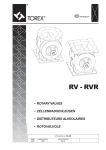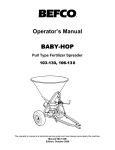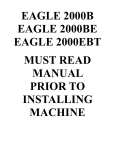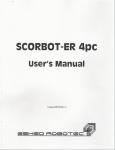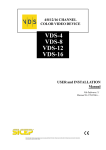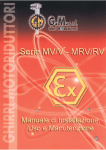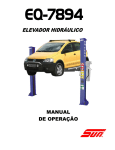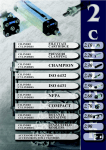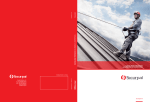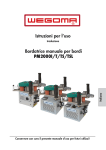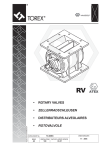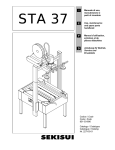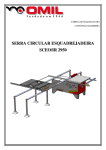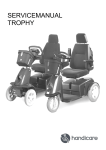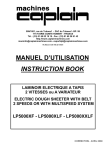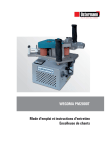Download 00008301_MANUALE_EDGING SYSTEM 3.50 - maggi
Transcript
WOODWORKING MACHINERY UK MACHINE CODE MANUAL CODE EDITION 18501101 00008299 05/2009 - REV00 ALWAYS KEEP THIS MANUAL TOGETHER WITH THE MACHINE EDGING SYSTEM 3.50 USE AND MAINTENANCE MANUAL Page intentionally left blank EC Declaration of Conformity The manufacturer Maggi Engineering S.r.l. Via delle Regioni, 299 - 50052 Certaldo (FI) ITALY Declares that the machinery The machinery Model EDGE BANDER EDGING SYSTEM 3.50 Ad o ta v i s e rg c a tr i m a ola complies with all relevant provisions of the directive: 2006/42/EC 2004/108/EC (Machine) (EMC) and compile the technical file of the above machinery. Certaldo The General Manager Page intentionally left blank page 5 WE WISH TO THANK YOU FOR CHOOSING ONE OF OUR PRODUCTS All the information, advices and important warnings for a correct use of the machine, have been inserted into this manual. This manual also contains the rules for a correct periodical maintenance to keep this machine in perfect efficiency. We suggest that all the chapters of this manual are thoroughly read before you use the machine for the very first time. INTRODUCTION Some information and illustrations in this manual may differ from the machine in your possession, since all the configurations inherent in the machine complete with all the OPTIONALS are described and illustrated. Therefore, refer only to that information strictly connected with the machine configuration you have purchased. The manufacturer in his pursuit of a policy of constant development and updating of the product may make any modifications without any prior notice. This manual has been drawn up exclusively for our customers’ use, guaranteeing that at the date of issue it constitutes the latest update of the documentation related to use of the product. Use of this manual is on full responsibility of the user. The manufacturer does not grant any further guarantee for any imperfections, incompleteness and/or operating difficulties, expressly excluding any responsibility for direct or indirect damage deriving from use of this documentation. MAGGI ENGINEERING reserves the right to make any modifications to the product described in this manual at any time without prior notice. All reproduction rights are reserved by MAGGI ENGINEERING. page 6 INDEX 1 1.1 1.2 1.3 GENERAL INFORMATION..……………………………………………………………………………………. MANUFACTURER’S DATA………………..……………………………………………………………………. MACHINE IDENTIFICATION…………...………………………………………………………………………. RECOMMENDATION FOR USE AND MAINTENANCE…...………………………………………………... 7 7 7 7 2 2.1 2.2 2.3 2.4 2.5 SPECIFICATIONS………………………………………………………………………………………………... 8 GENERAL DESCRIPTION OF THE MACHINE...……………………….……………………………………. 8 INTENDED USE………………….………………………………………………………………………………. 10 TECHNICAL DATA...…………………………………………………………………………………………..... 10 CONTROL PANEL…………...…………………………………………………………………………………… 11 MACHINE DIMENSIONS.……………………………………………………………………………………….. 12 3 3.1 3.2 3.3 3.4 3.5 3.6 INSTALLATION.………………………………………………………………………………….………………. 12 LIFTING AND TRANSPORTATION……………………………………………………………………………. 13 MACHINE PLACING…………………..…………………………………………………………………………. 13 ASSEMBLING PARTS..………………………………………………………………………………………….. 14 CONNECTING THE MACHINE TO ELECTRIC POWER SUPPLY……………..…………………………. 14 CONNECTING THE MACHINE TO PNEUMATIC POWER SUPPLY………………………………………. 15 CONNECTION TO SUCTION SYSTEM…………………...…………….……………………………………. 16 4 4.1 4.2 4.3 4.4 4.5 4.6 SET-UP……………………………….……………………………………………………………………………. 16 PNEUMATIC PRESSURE SET-UP………………………...………………………………………………….. 16 EDGE SET-UP……………………………………………………………………………………..……………... 16 FEEDER SET-UP……………………………………………………………………………………….………... 17 GLUE QUANTITY SET-UP………….…………………………………………………………………………... 18 ENTRANCE GUIDE SET-UP……..…………………………………………………………………………….. 19 TRIMMING DEPTH SET-UP……………………………………………………………………………...…….. 19 5 5.1 5.2 5.3 MACHINE USE………….………………………………………………………………………………………… 20 START AND STOP………...…………………………………………………………………………………….. 20 EDGE BANDING PANELS..….…………………………………………………………………………………. 21 SUGGESTIONS FOR USE….…………………………………………………………………………………... 22 6 6.1 6.2 6.3 6.4 6.5 6.6 6.7 6.8 6.9 SAFETY DEVICES AND RESIDUAL RISKS……..…………………………………………………………… 22 INTRODUCTION…………………………………………………………………………………………………. 22 GENERAL PRECAUTION.……………………………………………………………………………………... 23 SAFE WORKING OPERATIONS.…………………………………………………………………….………... 24 RESIDUAL RISKS………………………………………………………………………………………………... 24 CHECKING OF SAFETY PROTECTION DEVICES…………………………………………………………. 25 RISK DUE TO NOISE EMISSION LEVELS……………………………………………………………………. 25 RISK DUE TO DUST AND SMOKE EMISSIONS…………………………………………………………….. 26 RISK DUE TO VIBRATIONS…………..………………………………………………………………………... 26 PLATES AND PICTOGRAM...………………………………………………………………………………….. 26 7 7.1 7.2 7.3 7.3.1 7.3.2 7.3.3 7.4 MAINTENANCE.…………………………………………………………………………………………………. 27 CLEANING…………………………………………………..……………………………………………………. 27 GLUE REPLACEMENT.…………………………………………………………………………………………. 27 TOOLS REPLACEMENT….……………………………………………………………………………………... 28 FIRST CUTTING BLADE REPLACEMENT……………………………………………………..…………….. 29 END CUTTING BLADE REPLACEMENT…………………………………………………………………….. 29 REPLACING INSERTS OF END-TRIMMERS………...……………………………………………………… 29 ADJUSTING TENSION OF FEEDING BELT……………..…………………………………………………... 30 8 TROUBLESHOOTING………………………………………………………………….………………………... 31 9 DISMANTLING…………………...………………………………………………………………………………. 32 10 ELECTRIC DIAGRAM AND ELECTRIC COMPONENTS…..……………………………………………….. 32 11 PNEUMATIC DIAGRAM AND PNEUMATIC COMPONENTS………………..…………………………….. 34 12 TERMS OF GUARANTEE.…………………………………………………….………………………………... 35 13 SPARE PARTS…….…………………………………………………………………………………………….. 37 page 7 1. GENERAL INFORMATION 1.1 MANUFACTURER’S DATA 1.2. Manufacturer: MAGGI ENGINEERING S.r.l. Adress: Via delle Regioni, 299 - 50052 City: CERTALDO (FI) Nation: ITALY Tel. +39 0571 63541 Fax. +39 0571 664275 E-mail: [email protected] Web site: www.maggi-engineering.com MACHINE IDENTIFICATION The data impressed in the plate placed on the left side of the machine (from the point of view of the operator) identify the machine itself. When you eventually order spare parts or ask for any suggestions for use or maintenance, you have always to transmit the model type and identification number contained in the plate. It is absolutely forbidden to remove the plate or modify the data it contains. 1.3. RECOMMENDATION FOR USE AND MAINTENANCE In this manual we put into evidence all the operations for a correct use and ordinary maintenance of the machine. The machine must be used only by qualified users and personnel of age. The responsible for safety must be sure that users of the machine have read and understood all the information contained into this manual. The personnel for both ordinary and extraordinary maintenance must be well prepared in mechanics and electricity. Keep off any parts in movement of the machine. Keep particular attention to the finishing tools, the cutting tools, the feeding belt. Do not touch all the parts of the glue unit and the parts nearby: the unit work at very high temperature and there is high danger of burn. We strongly recommend not to make any other type of work, repair or operation not suggested in this manual. All the operations concerning disassembling parts must be done to authorised technical personnel. Always follow carefully all the instructions contained in this manual for a correct use of the machine. We suggest also to keep this manual in a place where the user can easily find and read it. A careful and conscientious observance of all the instructions written in this manual will afford you to use safely and correctly the machine. ANY ADULTERATION OR REMOVAL OF SAFETY PROTECTION DEVICES CAN CAUSE SEVERE DAMAGE. ANY REMOVAL, EXCLUSION OR MODIFICATION OF THESE DEVICES IS STRICTLY FORBIDDEN. YOU MUST VERIFY AND GUARANTEE THE PERFECT RUNNING OF SAFETY DEVICES BY MEANS OF PERIODIC CHECKS. ANY DEFECT OR PROBABLE DRAWBACK MUST BE IMMEDIATELY RESOLVED. page 8 2. SPECIFICATIONS 2.1. GENERAL DESCRIPTION OF THE MACHINE The machine was designed and built to apply edges with automatic feeding on straight wooden panels (and/or made of similar material) having square faces. Here below you can find a brief summary of the main characteristics of the machine: − Automatic edge banding machine for straight panels − Glue pot with motorized glue roller − Automatic guillotine with “with self-aligning system” for cutting the edge − Electronic regulation of the maximum/minimum glue pot temperature − Front/rear end-cutters with blades − High-frequency edge-trimming tools with widia-made cutters − Large copying disks assembled on ball-bearing − Adjustable input guide for the edge − Numerical counter for trimmers regulation − EC standards The main parts of the machine are: 1. Steel frame 2. Feeding belt for panels 3. Handwheel for adjusting height of feeding unit 4. Upper cover 5. Control panel 6. Reel support 7. Adjustable supporting feeding roll unit for large panels 8. Main switch 3 4 2 5 6 7 8 1 page 9 9 14 13 9. Suction hood 10. Pneumatic connection 11. Electric connection 12. Pneumatic panel 12 13. Electric panel 14. Panel for inspection and maintenance 10 11 15. Roller-made working table 16. Sliding rollers 20. Guillotine cutting unit 17. Edge banding inserting group 21. Edge-feeder rubber roller 18. Locking system for feeding belt 22. Pressing rollers structure 19. Edge gluing group 23. End cutter unit 24. Edge trimming unit 23 24 21 22 20 19 15 16 18 17 page 10 2.2. INTENDED USE − All the materials not similar to wood are not allowed: the end user is directly responsible for any damage caused by a different use of the machine respect the one specified in this manual and with different materials respect the ones the machine was designed for. − Always connect the machine to a well-dimensioned shaving suction system − It is strictly forbidden to modify any protection devices and use the machine if all the protection devices are not correctly installed − Any operation that does not comply with the instructions given herein is to be regarded as improper use. − It is strictly forbidden to modify any parts of the machine. If modifications are made, the Declaration of Conformity is no longer valid. − The data impressed in the plate placed on the left side of the machine identify the machine itself. When you eventually order spare parts or ask for any suggestions for use or maintenance, you have always to transmit the model type and identification number contained in the plate. − The machine was designed to be used by one operator only. Working position: A = insertion of the panel B = removal of the finished panel B A The manufacturer cannot be considered liable for any damage caused to people, animals or property resulting from improper use of the machine. 2.3. TECHNICAL DATA CHARACTERISTIC Dimensions of working plane Height of working plane Edge banding thickness (min/max) Working panel thickness (min/max) Motorized feeding belt speed Trimmer speed O.D. of edge trimmers (widia-made tool) O.D. of suction hood O.D. of reel Glue working temperature Glue pot capacity Feeling belt motor power Edge trimmer motor power Glue roller motor power Total installed power Net weight Working dimensions (max) Shipping dimensions (external) VALUE 2000 x 600 mm 840 mm 0,4 / 3 mm 14 / 50 mm ~ 6 m/min 12000 rpm 75 mm 90 mm 800 mm ~ 190°- 220°C 1,2 kg 0,25 kW 2 x 0,37 kW 0,25 kW ~ 2,4 kW 330 kg 2500 x 1550 x 1200 (H) mm 2100x760x1300 mm page 11 2.4. CONTROL PANEL A B F C G D E H A Edge trimming unit selector B End cutting unit selector C Feeling belt for panel selector D Glue pot heating (working mode) selector E Glue pot heating (stand-by) selector F Temperature regulator/display G Main power switch H Emergency mushroom button - It is a mechanically-operated push-button, to disconnect the button pull and rotate it clockwise selector: “O” = non active (OFF) Emergency button: “I” = active (ON) − Push in case of emergency Main power switch: Push to activate the electric power to the machine (the green light turns on) − Rotate clockwise to re-activate page 12 2.5. MACHINE DIMENSIONS Below you can find the main working dimensions of the machine (dimension in mm) 3. A B C1 C2 D E1 E2 H H tot 2500 2050 575 915 860 1175 1515 840 1190 INSTALLATION Lifting and handling should only be carried out by skilled personnel specially trained to execute this kind of operations. - Make sure that the area all around is free from obstacles and that no one is standing under the overhung load and/or within the system used to lift, move and/or transport the machine. - During all the handling operations pay maximum attention to prevent danger of damages to persons, things and to the machine itself. - page 13 3.1 LIFTING AND TRANSPORTATION The boring machine is packed in a wooden box and/or in cardboard and nylon. It is possible to move it by means of forklift, bridge crane (or crane), transpallet. Before starting the manoeuvres, free the machine of all the parts used for transport or packaging that have remained on the machine. Check that the capacity of the hoisting means is grater than the gross weight of the machine (please see the chapter named TECHNICAL DATA). In case of stocking, the machine must be kept in dry places, away from rain, snow or humidity. If you use a forklift or a transpallet to handle the machine: − If the machine is still placed on the pallet, insert the forks for lifting below the upper surface of the pallet until they protrude at least 15 cm from the rear part of the pallet; − If the machine is no more on the pallet, insert the forks for lifting below the central lower part of the frame of the machine until they protrude at least 15 cm from the rear part of the frame itself; − lift carefully and slowly, without causing the load to swing, and place the machine in the selected setting. If you use a bridge crane (or crane) to handle the machine: − Use appropriate lifting belt of the same length (approximately 2000 mm) of suitable capacity; − Fasten the slings to the bridge crane having adequate lifting capacity; − Move the bridge crane by small steps to allow the slings to settle, until optimum stability conditions are reached; − lift carefully and slowly, without causing the load to swing, and place the machine in the selected setting. 3.2. MACHINE PLACING It must be installed inside an illuminated, ventilated and closed industrial building having a solid and levelled floor, capable to support the weight of the machine itself; any possible difference in height must be in conformity with building rules. When the machine has to be placed on raised plain surface (higher floor) the load-bearing slab must be adequate to the weight of the machine. Temperatures from 5° C to 40° C with a humidity of max. 40% at 40° or max. 90% at 20°. Put the machine in the right place, as requested operative requirements, where it is easy to connect it to electrical and pneumatic power supply and to the suction system (if any). Put the machine in a place where there is enough lighting to see every part of the machine itself. The lighting of the premises must comply with the law in force in the Country where the machine has been installed. Lighting must grant complete visibility, avoid dangerous reflections, permit reading of the control panels and individuation of the emergency push buttons and must not interfere with other devices eventually installed on the machine. Adjust the levelling feet so that the machine is perfectly leaned on the floor, then align the working table of the machine by using a spirit level. To clean the machine do not use any solvent as gasoline and diesel oil, because they can damage the paint, making it dull, or oxidize other parts. page 14 3.3. ASSEMBLING PARTS The machine is shipped partially assembled, so it is necessary to assemble those parts given disassembled due to packaging and shipping requirements. Before starting assembling the parts, check that all the elements of the machine are complete and not damaged after transportation. REEL HOLDER: fix the reel holder frame to the rear part of the machine frame using screws, plain washers and nuts. 3.4. CONNECTION TO THE ELECTRIC POWER SUPPLY WARNING: THE ELECTRICAL CONNECTIONS, THE CHECKING AND ALL THE MAINTENANCE INTERVENTIONS ON THE ELECTRIC CIRCUIT MUST BE DONE BY QUALIFIED TECHNICAL PERSONNEL ONLY. We recommend not to connect the machine to the electrical power supply until it is not correctly placed in the right place. Before connecting the machine to the electrical power supply, it is necessary to verify that the electrical system corresponds to the following necessary power and safety requirements: − Make sure that the electrical circuit of the building where is placed the machine is correctly grounded and that the part of the circuit to be connected to the machine is perfectly working − Make sure that a differential thermal circuit breaker has been fitted upstream from the mains section connecting the machine (safety switch) − The electrical power line must carry an efficient neutral and ground line (grounded equipotential electrical system). − Presence of fuses or protection switches against short circuits on every conducing cable R-S-T, except the grounded one − The electrical power system must be in conformity with CEI 64.8 (CENELEC HD 384, IEC364-4-41) rules − Check that the mains voltage (V) and frequency (Hz) are as those indicated. − The tolerance of admissible voltage is +/-10% Besides: − The cable for ground connection is yellow-green. − The cable for neutral connection is sky-blue − Connect the phases to the R-S-T terminals, the neutral line to the N terminal and the ground line to the terminal with the ground-symbol For any further reference, please check the wiring diagram given together with this manual. description symbol ground colour Yellow-green neutral N phase R-S-T or L1 - L2 - L3 Sky-blue page 15 BE CAREFUL WITH THE ELECTRICAL CONNECTION - ALWAYS CONNECT THE NEUTRAL LINE - NEVER CONNECT FOR ANY REASON THE NEUTRAL TO THE GROUND - AN ERROR IN THE ELECTRICAL CONNECTION MAY CAUSE HAZARDOUS SITUATIONS FOR OPERATORS AND IRREPARABLE DAMAGE TO SOME MACHINE COMPONENTS The manufacturer is not responsible for damages caused by a wrong electrical connection of the machine or by problems due to malfunctioning of the electric connection or the electric power supply. Connect correctly the machine to the electric power supply, then start the machine and check that the feeding belt moves in the right direction (clockwise). If the feeding belt moves in the opposite direction, stop the machine, disconnect it to the power supply and invert two phases out of three in the electrical connection (R-S-T or L1-L2-L3); NEVER make modifications, for any reason, to the neutral and ground connections. 3.5. PNEUMATIC CONNECTION The required network pressure for the pneumatic system must be 7-8 bar at least. Use filtered, dehumidified, non-lubricated air to preserve all the pneumatic components of the machine from damage (lubrication damages the pneumatic system). Connect the machine with the pneumatic supply using a rubber-made or nylon-made pipe having a minimum I.D. of 8 mm. If the connecting pipe is longer than 5-6 meters, we suggest you to use a lager pipe, with at least an I.D. of 10 mm. We also suggest you to install a manual ON-OFF valve having a air-discharge system (if not given together with the machine) to easily disconnect the machine from the pneumatic air supply. ATTENTION: to guarantee the correct working conditions for all the pneumatic components, the machine has a device prevents it from starting if the air pressure is lower than 5 bar. Supplying pipe dimensions Air type Supplied air pressure I.D. 8 mm (10 mm for pipes longer than 5 meters) filtered, dehumidified, non-lubricated air 7-8 bar page 16 3.6. CONNECTION TO SUCTION SYSTEM Ø90mm A proper suction reduces at the minimum the risks for the operator of dust and smoke (due to glue heating) inhalation, besides aids better and more efficient functioning of the machine. Make sure that the suction system to which the machine has to be connected can guarantee a flow rate of at least 900 cu.m/h at a speed of about 20 m/s. Connect the suction system to the machine with a flexible tube of a 90 mm I.D. on the left side of the machine; tighten the tube with clamps. Position the tube in such a way to not obstacle any movements of the operator during normal working operations. The machine is delivered without exhaust system. The user has to install a proper exhaust fan depending on the type of use, the material and the timing of use of the machine. This system has to keep the dust concentration below the value allowed by the law of the country where the machine is installed. ALWAYS WORK WITH THE MACHINE CONNECTED TO THE SUCTION SYSTEM AND WITH THE SUCTION SYSTEM ON 4. SET-UP 4.1. PNEUMATIC PRESSURE SET-UP R2 The working pressure has been already set on correct values by the technical R1 personnel of the manufacturer. If necessary, you can operate on the handle of the pressure regulator to turn up/down the air pressure value. On the machine there are two air regulator groups, one on the left (R1) and one on the right (R2): R1 = pressure ±6 bar; it is connected to the electrovalves YV1 – YV2 – YV3 controlling the inserting edge cylinder (YV1), the cutting cylinder (YV2) and the end-cutting blades (YV3) R2 = pressure 3 - 3,5 bar; it is connected to the electrovalve (YV4) which T controls the pursuing phase of the end-cutter group. To unload condensation press upward the cap (T) of the left air regulator (R1) 4.2. EDGE SET-UP Check that the edge is of the right size for the thickness of the panel. The edge must not overlap more than 2 mm on each size of the panel (respect to the thickness of the panel itself) − Place the reel on the reel support as depicted in figure (A) − Lift the edge-guide up to the maximum necessary height working on the handle (B) − Lift the set-up washer (C) up to the maximum necessary height and lock it in position − Insert the edge land et it move on until it is close to the edge feeding roller (D) − Set-up the height of the edge-guide and then the set-up washer (leave room so that the edge can move freely), then lock in position. page 17 C B A D D C B For a correct work, it is important that the edge is properly guided and can move freely Work on the screw and the nut (W) in the edge-pushing group to regulate the exceeding length of the edge respect to W the front side of the panel. If you increase the length of the screw you reduce the length of the edge respect to the panel 4.3. FEEDER SET-UP E Work on the handwheel (E) until you see on the display (F) the same value of the thickness of the panel to be worked (black digit = millimetre, red digit = tens of millimetre). To regulate the height of the feeder respect to the working plane: − Unlock the feeder loosening the knob (G) − rotate the handwheel (E) until you reach the desired height; at the same time also the height of the edge-trimming unit is regulated − Lock the feeder tightening the knob (G) F page 18 − Incorrect adjustment of feeder height may cause faulty panel feed, thus compromising machine performance and working results − Always regulate the height of the feeder with the knob (G) loosened − Tighten the knob (G) before start working G If you regulate the height of the feeder with the locking knob (G) not loosened can cause permanent misalignment and damage the feeding of the panel Make sure that the feeder is well close and locked: the machine does not start working is the safety sensor placed on the feeder is not pressed. 4.4. GLUE QUANTITY SET-UP P The glue is applied on the panel through the glue roller (H). To regulate the quantity of the glue to be applied on the panel rotate the glue-regulator shaft (L) respect to the glue roller (H) To regulate the glue work on the system (P): the glue-regulator shaft (L) rotates by screwing/unscrewing the set-up screw. H L The system is very sensitive: with a small rotation of the glue-regulator shaft (L) we have a great variation on glue quantity. − WARNING: DANGER OF BURN, ALWAYS WEAR PROTECTIVE GLOVES − THE GLUE WORKING TEMPERATURE IS ABOUT 200°C, ALL THE COMPONENTS OF THE GLUE POT GROUP WORK AT HIGH TEMPERATURE M To work easily on the glue regulation system can be useful remove N the top polycarbonate-made cover (M) and/or open the feeder (N) ALWAYS TURN OFF THE MACHINE BEFORE REMOVING THE TOP COVER page 19 To regolate the quantità of the glue work on the system (P): rotate the device following the direction of the arrow (as depicted in the figure on the right) to increase the quantity of the glue put on the panel (we suggest you to increase the quantity of the glue as the porosity of the surface to be glued of the panel increases). Be careful: the system is very sensitive and with a very small rotation of the device you obtain a great variation in the quantity of the glue P Q Q Before any working session check that in the glue pot there is enough glue, by lifting the top (Q) 4.5. ENTRANCE GUIDE SET-UP An L-shape aluminium profile has given together with the machine. This profile has to be used when working with 2 mm thick edges: assemble the profile upon the fixed entrance guide, make sure it is in contact with the guide and then lock the fixing knobs. To remove the profile, loose the knobs and 4.6. TRIMMING DEPTH SET-UP The edge-trimmers are tools designed to remove the excess edging strips on both sides of the panel, top and bottom. The depth of trimming must be regulated depending on the thickness of the edge: you move the edge-trimmers close / away respect to the edge, so determining the quality of the finished edge. To adjust the trimming depth you work on the adjusting knobs placed on the rear part of the machine frame, close to the supporting column of the feeder. Act on the upper knob to move the upper edge-trimmer, act on the lower knob to move the lower edge-trimmer. Rotate the knob clockwise to move away the trimmer from the edge, rotate the knob counter clockwise to move the trimmer close to the panel. − The values depicted on the display are not equal to the thickness of the edge, they are used only as independent reference values − To eliminate errors caused by mechanical play, always reach the required value by turning the knobs counterclockwise (for example to reach the value 10, turn back up to 5 then rotate the knob up to 10) MADE ALL THE ADJUSTMENTS ONLY WITH THE MACHINE TURNED OFF page 20 5. MACHINE USE 5.1 START AND STOP To START THE MACHINE: − Turn the main switch (Z) to ON − Check that the feeder is close and lock in position − Press the main power button (G) on the control panel − Turn the glue heating selector (D) to “I” on the control panel: the temperature display (F) will show in red the actual value of the glue temperature, in green the target value. The machine will be Z ready to work only when the glue temperature reaches the target value. − Turn on the other working groups of the machine (A - B - C) to start working (turn each selector to “I”) A A Edge-trimming unit B End cutting unit C Feeding belt for the panel D Glue pot heating (working mode) E Glue pot heating (stand-by) F Temperature regulator - display G Main power button H Emergency mushroom button F B C G D E H After that the machine is ready to work, we suggest you to make preliminary edging tests on panels to verify that all the parameters and settings are correct To STOP THE MACHINE: Turn the main switch (Z) to OFF or press the emergency button (H) The open of the feeder causes the stop of the machine, as if the emergency pushbutton was pressed To RESTART THE MACHINE after that the emergency pushbutton has been pressed (or the feeder was opened) it is necessary: − Reactivate the emergency pushbutton (if it was pressed) − Press the main power button (G) on the control panel − Turn the glue heating selector (D) to “I” on the control panel: the temperature display (F) will show in red the actual value of the glue temperature, in green the target value. The machine will be ready to work only when the glue temperature reaches the target value. − Turn on the other working groups of the machine (A - B - C) to start working (turn each selector to “I”) GLUE HEATING To heat completely the glue in the glue pot up to the target temperature you must wait about 25 minutes. When there are short periods of inactivity (break longer than 15 minutes) we suggest to use the stand-by heating mode by selecting in the control panel the (E) button. The glue is maintained at a temperature value lower than the working one: you can easily and rapidly start again working after a period of break and at the same time there is no risk of damage for the glue due to overheating. page 21 The machine is ready to work only when the actual glue temperature reaches the target temperature PV = target glue temperature (final value) PV SV = measured actual glue temperature SU = increase the temperature value DOWN = dencrease the temperature value SV The working (target) temperature and the stand-by temperature have been set by the manufacturer and locked on the optimal value (working temperature = 195°C, stand-by temperature = DOWN UP 150°C); it is possible to change these values, once unlocked the protection, by following the instructions below: MODIFY THE WORKING TEMPERATURE Set the heating method of the glue to working mode turning the D selector on “I” position Set the target working temperature value using the UP and DOWN buttons on the temperature regulator until you reach the desired value on the display MODIFY THE STAND-BY TEMPERATURE Set the heating method of the glue to stand-by mode turning the E selector on “I” position Set the target working temperature value using the UP and DOWN buttons on the temperature regulator until you reach the desired value on the display In the following table some useful indications concerning some glue type are described: GLUE MANUFACTURER JOWAT JOWAT DURANTE&VIVAN NOBEL KLEIBEFIIT NATIONAL STARCH&CHEMICAL EMMEBI INTERNATIONAL RAKOLL DORUS GLUE TYPE JOWATHERM 280.00 JOWATHERM 288.30 DUDITERM 551 NOBELMELT NB-15 SUPRAMELT 774.4 INSTAWELD 7100 POLYBOND 3072 RSK K4/570 DORUS KS 208/2 WORKING TEMPERATURE 180/200°C 190/200°C 190/210°C 160/180°C 190/200°C 190/200°C 190/200°C 190/200°C 190/200°C NOTE: from our direct experience on the machine we have verified that choose the right glue for your application is very important to achieve good results 5.2 EDGE BANDING PANELS When the machine is ready to work, you can go on working and edging the panels: − Put the panel on the working table in the entrance side of the machine and move it in contact to the entrance guide. Move gently the panel below the feeding belt and put it always against the entrance guide. − The machine feeds automatically the panel, applies the edge, cuts the edge and finishes it until the panel ends its paths in the ending part of the working table, at the end of the feeder. − Take the panel from the working table page 22 5.3 SUGGESTIONS FOR USE To obtain good edge results it is necessary control many factors and variables occurring in the edging process, all of them can be classified into three categories: − PANEL TO BE EDGED: ∗ Use as much as possible good quality panels, with a sufficiently high density; ∗ The cut must be sharp, of high quality, without any chips, with a high quality of rectilinearity (at least ±0,1 mm per linear meter); ∗ The cut of the panel must be square (90°): the surfaces of the panel must be squared both compared with surface and to the thickness; ∗ The surface to be edged must be clean, free from dust and humidity; ∗ The panels must be stored at work room temperature, with no humidity. − HEAT-FUSIBLE GLUES ∗ Check that the glue is spread homogeneously along all the surface to be edged (along the thickness and the length of the panel); ∗ Use only heat-fusible glue suitable for the characteristics of the machine, of the edge and of the panel; ∗ Change the quantity of glue respect to the thickness and porosity of the panel; ∗ The glue deteriorates and losses its characteristics over time. If you use the machine only now and then, we suggest you to fill the glue pot with few glue and replace the glue with new one if and when necessary. − MACHINE SET-UP Start the machine, start the suction system and make the preliminary tests before start working, thus verifying thus following points: ∗ The height of the feeder is the same as the thickness of the panel; ∗ Regulation of entrance guide; ∗ Set-up of pneumatic pressure (if necessary); ∗ Check the quantity and quality of the glue in the glue pot; ∗ Glue working temperature; ∗ Adjust the quantity of the glue according to the kind of work to be done; ∗ Correct edge positioning; ∗ Set-up of the edge-trimming depth; ∗ Check that the edging strip sticks to the panel correctly. 6. SAFETY DEVICES AND RESIDUAL RISKS 6.1. INTRODUCTION The risk analysis and all the relative considerations in this chapter are based on: − knowledge of normal conditions and intended use of the machine, as described in this manual; − supposition that the machine is to be used to make single or multiple longitudinal cuts on wooden boards or composite panels; − supposition that all the workers have been correctly trained about residual risks of the working environment, as requested by current laws and regulations; − supposition that any other persons except workers, and especially non adult persons, are not allowed to go inside the working environment page 23 6.2. GENERAL PRECAUTION A machine of this type can be dangerous if it is not used properly. We strongly recommend that the operator comply with the following safety guidelines − The operator assigned to the machine must be well trained on its correct use, its safety protection devices and its accessories. − The machine devices must be correctly blocked and adjusted. − The whole machine must undergo ordinary and extraordinary maintenance procedures, following the scheduled timing. − Before using the machine, make sure to have read and understood this user manual. − Before making any operation with the machine, verify that the entire working area is free of persons and of any obstacles which could be potentially source of danger. − Verify that the connecting cable to the electrical power supply is safe, well stretched out and not rolled up. − Any intervention on the machine can be done only after that electrical and pneumatic connections are off. − Do not put any inflammable substances nearby the machine because of risk of explosion and/or fire due to possible sparks production. − The operator must think carefully about possible consequences before approaching with his hands the most dangerous areas of the machine. − Keep always the machine turned off when not in use; in case of not use for a long time disconnect the machine from electric and pneumatic power supply. − Avoid contact with hot parts All safety measures discussed in this handbook exclusively refer to the correct use of the machine authorised by the manufacturer. The use refers to the preparation, running and maintenance operations of the machine. Furthermore, it is strictly forbidden to use the machine for purposes other than those permitted by the manufacturer and to modify the machine and/or its parts without the manufacturer’s prior authorisation. The use of the following personal protections is also suggested for the operator, to prevent risks during placing, installation, set-up, use, ordinary and extraordinary maintenance: − gloves (for example for handling parts and replacing blades) − anti-crushing and anti-sliding safety shoes (for moving heavy and/or sharp parts) − goggles or shields (for protection against dust, shavings and residues in general, durino working on cleaning the machine) − anti-dust masks Moreover, the clothes must be suited to avoid danger of: − catching, dragging, crushing, sliding, abrasion − It is forbidden the use of contact lenses Besides, the operator must fulfil the main obligations that are listed hereunder: − keep the machine and the area around the machine clean and neat; − provide appropriate containers and/or defined areas for the storage of both the pieces to be machined and those already machined; page 24 − do not use the machine if you are not in a good state of health; − do not wear rings, necklaces, chains or bracelets as they could cause injuries; − use the personal protections mentioned in this handbook according to the operations to be carried out; − do not remove or modify the data plates installed on the machine by the manufacturer; − do not remove or bypass the safety devices of the machine. 6.3. SAFE WORKING OPERATIONS It is of basic importance that all the operators: − know perfectly the use, set up and maintenance operations to be performed on the machine; − know perfectly all the factors influencing the exposition to noise − know perfectly all the factors influencing the exposition to dust, for example: ∗ type of material to be worked, ∗ importance of dust extraction, ∗ correct setting of dust extraction devices; − that the dust extraction plant has to be turned on before start working. It is important that: − the floor of the area around the machine has to be plain, clean and neat; − lighting must grant complete visibility the working area; − raw material and finished parts are to be located close to working position of the operator. It is of basic importance for the operators: − use when necessary all the personal safety devices; this could mean: ∗ safety protections for ear to reduce risk of deafness, ∗ safety mouth mask to reduce the risk of breathing dangerous dust, ∗ safety protection gloves to handle blades (blades should be put into specified tool holders), − stop the machine when not attended; − report immediately any defect or failure, especially for safety guards or blades; − use safety procedures for cleaning and maintaining the machine, remove regularly and frequently chips and dust to avoid risk of fire; − follow the instructions of the constructor, the settings and repairing of the blades; − do not remove scraps or other residuals from the working area when the machine is turned on; − be sure that all the safety guards and the other safety devices are in position, in good conditions and subjected to correct maintenance. 6.4. RESIDUAL RISKS Despite all adopted safety protection devices, the following situations may be dangerous: − Contact with tools and/or blades − Contact with moving parts of the machine (chains, gears…) − Tool insert ejection − Electrocution from contact with live parts − danger due to incorrect tool installation − danger due to dust inhalation in case of working without suction system − danger of burns in case of contact with glue or other parts of the machine at high temperature, especially all around the area of the glue pot group (the glue pot and the glue roller, where there are the heating resistances, and all the parts nearby). The working temperature of the glue is about 180-200°C, all the parts close to the glue pot are at a decreasing temperature going from the glue pot to outside. page 25 Never touch, either directly or indirectly, any moving parts of the machine while in operation. Make sure that the machine is disconnected from the main power source before doing any cleaning, lubrication, maintenance, repair, adjustments, or part replacements. The operator should never leave the machine unattended when in use. 6.5. CHECKING OF THE SAFETY PROTECTION DEVICES WORK PLACE: before starting any work, check that the machine and the area surrounding it are clean and with no dust and/or scraps. Check that the working area is well enlightened and that the place for the parts to be worked and the ones already worked are tidy and close to the operator. B A C D FEEDER SAFETY SWITCH: the machine is equipped with a safety micro-switch (see A) that is turned on when the feeder is opened and stops all the operations of the machine. Check periodically the integrity of the device and its correct work. UPPER PROTECTION COVER: the upper cover reduces the access to the functional groups of the machine (see B) so avoiding the operator to touch the main dangerous parts of the machine. Check periodically the integrity of the cover and of the polycarbonate-made door, replace them if necessary. EMERGENCY PUSHBUTTON: it is placed in the control panel (see C). Check periodically its correct working. CHIP, DUST AND SMOKE COLLECTION: the machine is equipped with a hood (see D) for the connection with the suction system. Check periodically that the collecting hoods are complete and correctly connected with the suction system. 6.6. RISK DUE TO NOISE EMISSION LEVELS The machine has been designed so as to reduce at the source the noise emission level. The noise levels of the machine are the following: Reference standard ISO 7960 Machine on, not working, suction system off Machine is regularly working Level of soundpower released LW dB W (A) 83,8 91,3 Level of sound pressure at operator position Lop dB (A) 70,4 81,2 page 26 NOTE The indicated noise levels are emission levels and do not necessarily represent safe operation levels. Even though there is a relation between emission levels and exposure levels, it cannot be used in a reliable way to determine whether additional precautions are to be taken. The factors that determine the exposure level that manpower is subjected to include the length of the exposure, the characteristics of the working place, other sources of dust and noise, etc., that is the number of machines and other adjacent processing. Allowed exposure levels may vary from country to country. In any case, this information will help the user of the machine to better evaluate danger and risks. To not exceed the noise level it is necessary following strictly these rules: − check and replace periodically all the cutting tools and their fixing devices; − clean and lubricate all the parts of the machine as suggested in this manual. 6.7. RISK DUE TO DUST AND SMOKE EMISSION The machine is designed to work in close environment, so it is necessary to connect it to a suitable dust extraction system which complies with the EN 12779 regulation. To not exceed the dust emission level it is necessary following strictly these rules: − always turn on the dust extraction system before start working with the machine; − clean regularly (as written in this manual) the parts of the machine; − check regularly that the dust extraction system works properly; − check that the parts of the machine are not damaged or closed by dust and/or scraps. 6.8. RISK DUE TO VIBRATIONS The vibration level is not so high to cause danger for the operator, during normal and correct use of the machine, as written in this manual. 6.9. PLATES AND PICTOGRAM Always check that figures, colours, words of the safety signs are in good state. If damaged or worn, It is necessary to replace them suddenly and call the responsible of the manufacturing plant of your firm. page 27 7. MAINTENANCE − − The operator must disconnect the machine from the power source (electric and pneumatic) before executing any maintenance operation. Always wear personal protection devices An adequate maintenance is a crucial factor to obtain optimal working condition and a longer life of the machine. Always follow the procedures and recommendations described in this manual 7.1. CLEANING Regular cleaning of all machine parts and the surrounding environment means greater operating safety and a prolonged machine's life. Before making any kind of cleaning, be sure that all the parts are cold (or at room temperature) AFTER EACH WORK CYCLE AND AT THE END OF WORK PERIOD Accurately clean the machine and all its components, removing with a suction hood chips and dust. Use compressed air only when strictly necessary, using protective glasses and a mask. It is very important that the following parts of the machine are as clean as possible from glue residues: − Sliding rollers and working table (A) − Edge-feeding roller (B) E D − Edge-pressing rollers (C) − End cutter (D) C B − Copying disks and tools, end-trimming unit (E) We suggest you to protect the cutting parts of the endtrimming unit and of the end-cutting unit using a A unlocking spray in order to reduce as much as possible the deposit of glue residuals. Ask your glue supplier for any information regarding this unlocking spray. Always remember to wear a protective mask when using spray. 7.2. GLUE REPLACEMENT The glue looses its adhesive properties and deteriorates over time. It is necessary replace the glue to be sure to obtain first quality products. It could be also necessary to replace the glue when edging different materials or with other characteristics (edges and/or panels). Always wear protective gloves to not burn your hands page 28 EMPTYING OUT PROCEDURE: − When the machine is cold, loose the emptying top (T) located in the bottom part of the glue pot (V) − Put a capable container just T below the glue pot − Turn on the machine and activate the heating of the glue pot (F) turning the selector to “I” − Wait for the glue reaches the target temperature: the solid V glue melts gradually when the temperature goes up and pours down into the container through the emptying hole − Remove the top cover (Q) and clean with a wooden or plastic spatula glue scraps eventually remained inside the glue pot. Please be carefully in using the spatula: do not damage the protective material of the glue Q pot − Clean carefully the area where the emptying top (T) is screwed F − When the glue pot is empty and clean, screw the emptying top in the bottom part of the glue pot (please remember to perform the operation when the glue pot is not cold: if any glue residuals are solidified, it is very difficult to tighten again the emptying top in its seat) − Do not use metallic tools o clean the glue pot to preserve the protective material of the glue pot from damages − Unscrew the emptying top from the bottom of the glue pot when the glue pot is cold before starting the emptying procedure − Tighten the emptying top only before that the glue pot is empty and that the seat of the top is completely clean 7.3. TOOLS REPLACEMENT − − Always wear protective gloves to handle tools Disconnect the machine from the pneumatic air supply and turn of the machine before going on replacing tools Check periodically the sharpness of tools, if necessary re-sharpen or substitute them. To get access to tools it is necessary to open the feeder (N) M and in some cases the upper protection cover (M). ALWAYS TURN OFF THE MACHINE BEFORE REMOVING THE UPPER COVER N page 29 7.3.1. FIRST CUTTING BLADE REPLACEMENT M − Unscrew and remove screws, L springs and washer (S) P − Disconnect the blade (L) from the cylinder rod (P) removing the R S connecting fork (R) − Replace the blade and mount again the parts following the previous procedure from bottom S R to top The screws (S) are not to be tighten, they have to be screw gently for the length useful for the blade to slip on the counter blade (M) without excessive plays. 7.3.2. END CUTTING BLADE REPLACEMENT CI To replace the blade (LI) of the end-cutter unit, unscrew and remove the two 2 screws (1), replace the blade, then screw again and tighten the screws. Repeat the same procedure for the other blade. Never work on the screws (2) used to fix the counter blade (CL) of the end- LI cutter unit to the support. 1 7.3.3. REPLACING INSERTS OF END-TRIMMERS To change inserts of the end-trimmers you have to follow two different procedures, M one for the upper end-trimmer and another one for the lower end-trimmer. In both cases you have to remove firstly the upper protection cover (M) and the cover of the endtrimmers (M1) unscrewing the fixing screws. M1 The inserts of the end-trimmers must be replaced all together. To replace the inserts you have to unscrew the locking screws (VF) from the body of the end-trimmer. VF CF UPPER END-TRIMMER − Remove the top cover (CF) unscrewing the screws which fix it to the steel support: now you can reach the end-trimmer − Replace the inserts working on the locking screws (VF) − Mount again the top cover (CF) page 30 LOWER END-TRIMMER − Lift up the feeder up to its maximum height turning the handwheel − Remove the reference guide (GR) unscrewing the locking screws which fix it to the frame BS − Replace the inserts working on the locking GR screws (VF) BS VB − Mount again the reference guide (GR) locking the screws: please be sure that the guide is in contact with the supports (BS) BS GR BS VF 7.4. ADJUSTING TENSION OF FEEDING BELT Check the tension after the first 20 working hours and periodically after every 150 working hours. To check the tension follow these instructions: − Loose the locking knob and open the feeder − Hang up a weight of 4 kg in the middle of the feeding belt, check that belt stretch (H) is between 20 and 30 mm If necessary regulate the tension of the belt working on the tensioning screws (VT): act on the two screws in the same manner, rotate them with the same number of revolutions to keep the correct alignment of the tensioning roll. 4 kg VT VT page 31 8. TROUBLESHOOTING WARNING: BEFORE MAKING ANY INTERVENTION YOU MUST DISCONNECT THE MACHINE FROM ELECTRIC AND PNEUMATIC POWER SUPPLY PROBLEM THE MACHINE DOES NOT START WHEN IT IS TURNED ON OR STOPS DURING A MACHINING CYCLE THE PANEL DOES NOT SLIDE THE EDGE IS NOT FED CAUSE SOLUTIONS Lack of line voltage Fuses blown Emergency on Safety microswitch on Overload thermal switch triggered because of: − Power supply cable crosssection too small − Drop in voltage due to cable power supply too long − Short circuit in the electric system 6. Air pressure supply too low 7. Glue temperature below 190°C (or too low respect the working target temperature) 1. Check with a tester that there is power on the three phases 2. Check that fuses are complete; if necessary replace them 3. Disconnect the emergency pushbutton pulling and rotating it counter clockwise 4. Check that the feeder is completely and correctly closed: if it is opened, the safety microswitch is turned on and the machine stops 5. The overloads in the electric panels work as thermal protection for the motors. Solve the cause for the machine stop and press the button to re-activate the overloads 6. The machine is equipped with a pressure switch that prevent it from starting if the air pressure is below 5 bar. Restore the correct value of the air pressure supplied (7-8 bar) 7. The machine is ready to start working only when the glue temperature has reached the target working temperature (about 190°C). If the glue can not reach this temperature in 25 minutes or so, you have to check if the electric components are undamaged. 1. 2. 3. 4. 5. 1. Feeder height setting non correct respect panel thickness 2. Feeder not parallel to the working table in direction of panel feed 1. Incorrect panel insertion 2. Jammed edge 3. Edge not correctly inserted 1. The panel has edges that are not linear or not perpendicular 2. The edge is not glued in the entrance part of the panel and there is too much glue 3. There are traces of humidity and/or dust on the edges of the THE EDGE IS NOT panel CLOSE-FITTING AND PROPERLY GLUED 4. The temperature of the panel is too low 5. The panel is too large 6. Not enough glue applied onto the panel 7. The glue is deteriorated 8. The glue pot is empty 1. Adjust the height of the feeder respect to panel thickness, check the value on the display of the handwheel. During adjusting operations the locking knob must be loosen. Tighten again the locking knob at the end of the adjustment procedure. 2. Repeat the adjustment of feeder height making sure that the locking knob is loosened 1. Insert the panel keeping against the entrance guide and accompanying it until it is not fed by the feeder 2. Check that the edge is free to move and slide along the path and that is correctly guided (there must be a play of at least 0.5 mm between the edge and the guiding structure) 3. Check that the edge is correctly inserted in the edgeguiding support and it has been fed by the edge-feeding system 1. The cut must be net, of high quality, with no chips, with high rectilinearity (at least ±0,1 mm for linear meter). The cut must be squared (90°): the faces of the panel must be perpendicular both respect the surface and the thickness. 2. Check that the edge is not too thick (max 2 mm). Adjust the entrance guide respect the edge thickness to apply. 3. The panels must be stored in dry and clean environment, with no humidity. 4. The panel must be stored at room working temperature 5. Support panels and accompany them until the endo of th working path 6. Set-up the quantity of glue: increase the quantity of glue as the total edge-banding area of the panel increases 7. The glue losses its characteristics and deteriorates overtime: it is necessary to replace it 8. Add glue in the glue pot page 32 9. DISMANTLING Waste and refuse produced during machining must be collected, recycled or eliminated according to the regulations in force of the country where the machine has been installed. Waste produced during machining on this machine are: − raw material scrap (chips, shavings, etc.). − dust When machine has to be put out of service, please carefully follow our instructions in order to safeguard the safety of people and of environment. − Separate all plastic-made parts to be disposed as differentiated materials following the current rules and laws − The mechanical component parts, built of steel, aluminium etc. or alloys shall be sorted in order to facilitate the process by which these are either sent to storage or to recycling − Dismantle electric and pneumatic components so that you can re-use them after a check or a revision − Do not waste in the environment non-biodegradable products, lubricant oils and non-ferrous components (rubber, resins,…) − Call a specialized company to rescue and eliminate solid and liquid materials; dispose all the collected materials following the current rules and laws 10. ELECTRIC DIAGRAM AND ELECTRIC COMPONENTS For the wiring diagram please see the document attached with this manual. In the following pages you can find a description of the main electric components of the machine. C A E D H F G I B A = TRANSFORMER F = TIMERS B = POWER TERMINAL BOARD G = AUXILIARY POWER RELAY C = AUXILIARY TERMINAL BOARD H = POWER CONTACTOR + OVERLOAD CUTOUT D = POWER CONTACTOR I = INVERTER E = FUSES page 33 TEMP1 TEMP3 TIMER TEMP1 = edge insertion (1,5 seconds) (*) TEMP2 = cycle reset (4 seconds) (*) TEMP3 = cutting group moving delay (0,1 – 0,2 seconds) (*) TEMP4 = cutting group delay (1,8 – 2 seconds): it regulates the overlenght of the edge respect to the rear part of the panel (*) (*) = these approximate values with a tolerance of +/-10% TEMP4 TEMP2 POWER CONTACTOR + OVERLOAD CUTOUT They work only if there is a failure in the motors (the motor does not move, the contactor is out of service or there is an overload for the motor) SAFETY SWITCH SQ1 SQ1 = safety switch to detect that the feeder is correctly closed: if its NOT correctly pressed, the machine DOES NOT start; if you open the feeder when the machine is working (so the safety switch is not pressed) the machine stops SQ3 SQ6 SQ2 SWITCH OF THE CUTTING GROUP SQ5 SQ4 − SQ3 = presence switch to detect that the panel has passed; it is connected to timers and controls the action of the edge insertion group and the cutting group − SQ2 = presence switch to detect that the panel has passed; it regulates the timing of the inserting group and the cutting group SWITCHES OF THE END-CUTTING GROUP SQ4 SQ5 − SQ4 = it has two main functions: 1. if it is pressed, allow the YV3 electrovalve to cut the edge (cutting group) 2. if it is pressed and also SQ5 is still pressed, the YV4 electrovalve can not allow the moving cylinder to move the cutting group to reach the panel − SQ5 = if it is pressed, the YV4 electrovalve allow the moving cylinder to move the end-cutting group to reach the panel − SQ6 = end-stroke sensor page 34 11. PNEUMATIC DIAGRAM AND PNEUMATIC COMPONENTS For the pneumatic diagram please see the document attached with this manual. In the following pages you can find a description of the main pneumatic components of the machine. INLET PRESSURE REGULATOR R1 = air pressure ±6 bar, It is connected to the electrovalves named YV1 – YV2 – YV3 R2 = air pressure 3 - 3,5 bar, It is connected to the electrovalve named R1 R2 YV4 which controls the cutting unit YV4 YV1 YV PS YV2 ELECTROVALVES YV1 = it controls the cylinder for edge insertion (black Ø6 pipes) YV2 = it controls the cylinder for edge cutting (orange Ø8 pipes) YV3 = it controls the cutting cylinder (which moves the cutters) of the cutting group (orange Ø8 pipes) YV4 = it controls the moving cylinder of the cutting group (black Ø6 pipes) PS = pressure switch; it is powered at 110 V, if there is no (or low) pressure the machine does not start R3 PRESSURE REGULATOR R3 = about 1 bar It regulates the pressure that works against the panel when it is in contact with the cutting group page 35 12. TERMS OF GUARANTEE The guarantee provided with this certificate is valid for the period of one year from the date of purchase. Consequently, during such guarantee period, the manufacturer undertakes to replace any parts found to be faulty because of manufacturing defects. Only carriage expenses will be on the customer’s account. The guarantee is void if the machine has been used improperly or damaged during transport. GUARANTEE CERTIFICATE The machine has been built according to technological and safety criteria and has been checked in our factory before being forwarded. MAGGI ENGINEERING guarantees machine working and quality in agreement with law rules, for a period of 12 months. Improper use and incorrect maintenance, not following the rules contained in this manual, as well as adjustments or modifications not approved by the manufacturer, cancel all the terms of guarantee. The conditions of guarantee about the correct working of the machine are strictly connected to the respect of all the indications described in the USE AND MAINTENANCE MANUAL. The free replacement of any parts found to be faulty is done only after having checked that the machine had been properly used. Claims and guarantee interventions request are accepted only against presentation of the machine number engraved into the identification plate. Upon receipt of the machine carefully check that packaging is safe and not damaged. Except for different agreement, the manufacturer is not responsible for any damages done during transport. In case of evident damages on packaging, we suggest to contact immediately the carriers. Our firm will be available to give the necessary support. COUPON TO BE FORWARDED TO THE MANUFACTURER GUARANTEE AND LOOK-OVER COUPON Model...……………………………………..Serial number…………………………………………... Name…………………………………………………………………………………………………………….. Address………………………………………………………………………………………………………….. ZIP Code…………………………………...City……………………………………………………………… Date of purchase…………………………. Dealer…………………………………………………………... Owner’s signature ………………………………………….. The purchaser states to accept all the terms of guarantee and to have checked the machine to work well page 36 NOTE Send to: Sales and technical Assistance Via delle Regioni n°299 50052 CERTALDO (Fi) ITALY page 37 13. SPARE PARTS POS. GROUP NAME REFERENCE SHEET 1 FRAME UNIT SHEET 1 2 SUPPORTING ROLL UNIT SHEET 2 3 FEEDING UNIT SHEET 3 4 END CUTTER UNIT SHEET 4 5 END TRIMMING UNIT SHEET 5 6 GLUE POT UNIT SHEET 6 3 1 2 5 4 6 page 38 SHEET 1 FRAME UNIT page 39 FRAME UNIT POS. 1 2 3 4 5 6 7 8 9 10 11 12 13 14 15 16 17 18 19 20 21 22 23 24 25 26 27 28 29 30 31 32 33 34 35 36 37 38 39 40 41 42 43 44 45 46 47 48 49 50 51 52 53 54 55 56 57 58 59 60 61 62 63 64 65 66 67 68 69 70 71 72 73 74 75 76 77 CODE 00000041 00000048 00000145 00000150 00003118 00003125 00003430 00003431 00004004 00004111 00008507 00014213 00018303 00018307 00018335 00018378 00018404 00018462 00018500 00018503 00018507 00018520 00018521 00018522 00018523 00018524 00018527 00018534 00018602 00018613 00018622 00018720 00061003 00340607 36050032 38500230 38500236 38500237 38500241 38500308 38500322 38500367 38500368 38500375 38500376 38500377 38500380 38500388 38500390 38500399 38500554 38500721 38500908 38500909 38510302 38510306 38510316 38510330 38510336 38510340 38510342 38510345 38510346 38510348 38510355 38510356 38510365 38510367 38510368 38510369 38510391 38520348 38520361 38520363 38520364 38520381 38520382 PART NAME PLAIN WASHER SCHNOR M6 SPRING Øe18,8 Øi10,2 s0,35 SELF-LOCKING NUT M8 UNI-7473 ZINC. SELF-LOCKING NUT M10 UNI-7473 ZINC. HANDWHEEL ELESA VTL 3580B M10 (FEMMINA) BOTECO HANDLE 732-30 M6x30 BEARING INA AXK1528 RING INA AS 1528 GAMM C48/A HINGE SLIDING ROLLER SP15LBD HOOK 509 DIAM19 PVC ROLLER Ø40 L350 MOLLA (RS 301-5904) SCREW VTCEI M6x20 ZINC SCREW TCEI M8X16 UNI-5931 ZINC. SCREW VTCEI M6x35 ZINC. SCREW VTCEI M8 x 45 UNI5931 ZINC. SCREW TE M8x35 UNI-5739 ZINC. SCREW VTBEI M6x16 ISO7380 ZINC. NUT M6 UNI-5588 6S ZINC. NUT M10 UNI-5588 6S ZINC. NUT M12 UNI-5588 6S ZINC. PLAIN WASHER Ø6 UNI-6592 ZINC. PLAIN WASHER Ø8 UNI-6592 ZINC. PLAIN WASHER Ø10 UNI-6592 ZINC. PLAIN WASHER Ø13 UNI-6592 ZINC. PLAIN WASHER Ø17 UNI-6592 ZINC. PLAIN WASHER Ø8x24 ZINC PLAIN WASHER Ø12x36 UNI3351 ZINC. SCREW TBCEI M10X30 ISO-7380 ZINC. SCREW VTBEI M8X10 SCREW TBCEI M6X30 ISO-7380 ZINC. SCREW TBCEI M6 x 8 ISO-7380 ZINC. SCREW VTCEI M10x30 SCREW VTE M6x20 FOOT MILLING PLATE BRUSH PROFILE BRUSH MILL SUCTION STRUCTURE ROLLER EDGE SPACER MEDIUM SPACER LOW SPACER FEEDER BLOCK CONTROBLOCCO TRASCINATORE ELECTRIC BOX COVER ADJUSTING SUPPORT MICROSWITCH SUPPORT CABLE COVER FEEDER MILLIMETRED RULE MICROSWITCH SUPPORT SPACER CONTROL PANEL FRONT PANEL CONTROL PANEL PLATE CONTROL PANEL CONSOLLE FRONT PLATE PNEUMATIC BOX REAR COVER DISK SUPPORT CENTRAL DISK REAR COVER DOOR REAR CLOSING PANEL HINGE SPACER SLIDING PLATE FRAME ROLL CENTRAL SLIDING PLATE LOW SPACER PLATE SPACER SEPARATION WALL ENTRANCE MICROSWITCH SUPPORT SLIDING PLATE LOCKING COLUMN ENTRANCE FENCE EXIT FENCE CONSOLLE FIXING TUBE CONSOLLE PIN Q.TY 24 2 1 1 1 1 1 2 2 23 1 4 24 4 13 1 4 1 1 2 4 5 2 5 5 1 4 1 1 1 4 6 2 1 4 1 3 3 1 4 1 2 2 1 1 1 1 2 1 1 1 2 1 1 1 1 1 1 1 1 1 1 2 1 1 12 1 1 11 1 1 1 1 1 1 1 1 page 40 SHEET 2 SUPPORTING ROLL UNIT page 41 SUPPORTING ROLL UNIT POS. CODE PART NAME Q.TY 1 00000139 NUT M5 UNI-5588 6S ZINC. 8 2 00000140 PLAIN WASHER Ø5 UNI-6592 ZINC. 16 3 00003033 BALL-BUSHING KH2540PP 4 4 00004111 SLIDING SUPPORT SP15LBD 25 5 00005201 END STOPPER 1 6 00018322 SCREW TCEI M8X20 UNI-5931 ZINC. 2 7 00018609 SCREW TBCEI M5X16 ISO-7380 ZINC. 16 8 00020404 SCREW VTCEI M4 x 12 1 9 00050808 SCREW VTCEI M8x35 2 10 38500911 SUPPORTING ROLL BASE 2 11 38510901 ROLL UNIT SUPPORT 2 12 38510902 ROLL UNIT BEAM 1 13 38510906 ROLL UNIT GUIDE 2 14 49900051 TRANSVERSE WASHER 2 page 42 SHEET 3 FEEDING UNIT FEEDING UNIT POS. CODE 1 00000034 2 00000147 3 00000223 4 00003388 5 00003424 6 00003430 7 00003431 8 00003959 9 00004048 10 00004600 11 00005095 12 00005201 13 00014307 14 00018308 15 00018323 16 00018378 17 00018418 18 00018500 19 00018521 20 00140601 21 00150818 22 38500520 23 38500522 24 38500523 25 38500527 26 38500530 27 38500538 28 38500539 29 38500542 30 38500544 31 38500545 32 38500548 33 38500549 34 38500550 35 38500553 36 38500555 37 38500907 38 38510501 39* 38510511 40 38510519 41 38510524 42 38510525 43 38510526 44 38510528 45 38510531 46 38510543 47 38520505 48 385XX534 page 43 PART NAME Q.TY SPACING WASHER PS-20X28X1 2 SELF-LOCKING NUT M12 UNI-7473 ZINC. 1 PARALLEL KEY 6x6x60 UNI-6604 A 2 SEEGER RING E18 1 SKF BALL BEARING 6001 2RS1 1 BEARING INA AXK1528 2 RING INA AS 1528 4 COUNTER ELESA DD52-AR-0002.5-D-AR 1 SCREW M 6 X 16 UNI-5927 4 FEEDING BELT 1 BUSH PAP 2010 P10 2 END STOPPER 1 MOTOR CHT63B4 0,18 Kw + REDUCER NMRV040 PAM 1/60+FLANGE F(FA) D110 1 SCREW TCEI M8X30 UNI-5931 ZINC. 6 SCREW TCEI M8X60 UNI-5931 ZINC. 2 SCREW VTCEI M8 x 45 UNI5931 ZINC. 6 SCREW VTBEI M8X20 12 NUT M6 UNI-5588 6S ZINC. 1 PLAIN WASHER Ø8 UNI-6592 ZINC. 22 SCREW VTSTEI M6x30 1 BUSH FE-PTFE 45X50X20 2 BELT TENSIONING SHAFT 1 TENSIONING ROLLER 1 BELT MOTOR SHAFT 1 LIFTING SEAT 2 LIFTING SHAFT 1 BOTECO HANDWHEEL D207 130 D12 RAL2004 1 SAFETY PLATE 1 HANDWHEEL PLATE 1 LOCKING KNOB PLATE 1 LIFTING PARALLEL KEY 2 ROTATION FORK 1 ADJUSTING BUSH 6 ADJUSTING NUT 6 FEEDER BUSH 2 END STOP SPACER 1 FRONTAL PLATE 1 FEEDING COVER 1 FEEDING BEAM 1 BELT GUIDE 1 LIFTING SUPPORT 1 FEEDER ROTATION SUPPORT 1 LIFTING SCREW 1 LIFTING NUT 1 LOCKING FORK 1 THICKNESS PLATE 1 FEEDING COLUMN 1 MOTOR ROLLER 1 page 44 SHEET 4 END CUTTER UNIT page 45 END CUTTER UNIT POS. CODE 1 * PART NAME Q.TY KPN JOINT RD000003 1 2 00000044 SPACING WASHER PS Ø14X20X1 2 3 00001161 GASKET CORTECO NADUOP 63-1 1 4 00001163 PNEUMATIC CYLINDER 1260 Ø16 100 1 5 00001501 GASKET Øi20 Øe28 1 6 00003028 BALL BUSHING SKF LBBR 12-HV6 4 7 00003421 BALL BEARING 61801-2RS 4 8 00005095 BUSH PAP 2010 P10 1 9 00018308 SCREW TCEI M8X30 UNI-5931 ZINC. 1 10 00018323 SCREW TCEI M8X60 UNI-5931 ZINC. 2 11 00018339 SCREW VTCEI M8x12 ZINCATA 4 12 00018340 SCREW TCEI M8X25 UNI-5931 ZINC. 4 13 00018344 SCREW TCEI M6x16 UNI 5931 ZINC 4 14 00018344 SCREW TCEI M5x16 UNI 5931 ZINC 4 15 00018431 SCREW TBCEI M6X20 ISO-7380 ZINC. 4 16 00018439 SCREW TSPEI M4x8 UNI-5933 ZINC. 4 17 00018441 SCREW VTBCEI M6x10 2 18 00018520 PLAIN WASHER Ø6 UNI-6592 ZINC. 3 19 00018521 PLAIN WASHER Ø8 UNI-6592 ZINC. 5 20 00018522 PLAIN WASHER Ø10 UNI-6592 ZINC. 1 21 00018601 SCREW TBCEI M10X20 ISO-7380 ZINC. 1 22 001508024 BUSH IGUS GSM-1012-15 4 23 37600617 SPRING 2 24 38500703 END CUTTER COUNTERBLADE 2 25 38500704 SLIDING GUIDE 2 26 38500706 END STROKE PLATE 1 27 38500708 END CUTTER SUPPORT 2 28 38500716 END CUTTER BLADE 2 29 38500717 CARRIAGE STOPPER 2 30 38510701 END CUTTER SUPPORT 1 31 38510702 END CUTTER CARRIAGE 1 32 38510709 END CUTTER CAM 1 33 38510711 CYLINDER HEAD 63 1 34 38510712 END CUTTER GUIDE 2 35 38510713 END CUTTER CYLINDER ROD 1 36 38510722 END CUTTER ROLLER 2 37 38520707 END CUTTER BEARING SUPPORT 2 38 38520718 BLADE STOPPER 1 39 38530705 END CUTTER ECCENTRIC PIN 2 page 46 SHEET 5 END TRIMMING UNIT page 47 END TRIMMING UNIT POS. 1 2 3 4 5 6 7 8 9 10 11 12 13 14 15 16 17 18 19 20 21 22 23 24 25 26 27 28 29 30 31 32 33 34 35 36 37 38 39 40 41 42 43 44 45 46 47 48 49 50 51 CODE * 00000017 00000037 00000048 00000049 00000144 00003038 00003337 00003350 00003365 00003424 00003461 00003986 00005015 00018317 00018320 00018333 00018498 00018526 00018621 00040616 00120406 00361003 00530505 28500204 38500203 38500207 38500208 38500209 38500210 38500211 38500214 38500218 38500219 38500229 38500232 38500233 38500234 38500235 38500239 38500240 38500244 38500245 38501201 38510202 38510204 38510212 38510213 38510217 38520225 45400027 PART NAME SCREW TBCEI M12X16 ISO-7380 ZINC PLAIN WASHER Ø5 UNI-6592 BRUN. SPACING WASHER PS Ø12X18X1 SPRING Øe18,8 Øi10,2 s0,35 SPRING Øe28 Øi12 s1 SELF LOCKING NUT M6 UNI-7473 ZINC. RUNNER BLOCK ABBA BRS 15-B SEEGER RING I28 SEEGER RING 10 E SEEGER RING E28 SKF BALL BEARING 6001 2RS1 RING INA AS 1024 COUNTER VO-SX_1.0 AR.D.10 BUSH Ø14-Ø10-L14 SCREW VTCEI M6x8 SCREW VTCEI M6x65 ZINC. SCREW TCEI M 6X12 UNI 5931 ZINC. MOTOR NUT M16x1-5 PLAIN WASHER Ø6x18 UNI3351 ZINC. SCREW TBCEI M5x14 ISO 7380 ZINC. SCREW VTCEI M6x80 SCREW VTSTEI M4x15 UNI 5923 SCREW TE M10 X 10 5739 bru. SCREW VTSPEI M5x10 ELECTROSPINDLE NC35-B TEKNOMOTOR END TRIMMING PLATE LOWER END TRIMMING MOVING SCREW INDEX SUPPORT END TRIMMING DISK END TRIMMING GUIDEABBA BR_15_RIF END TRIMMING DISK COLUMN END TRIMMING COLUMN RH TRIMMER LH TRIMMER ADJUSTING THREADED BAR SPRING REFERENCE LOWER SPRING MEDIUM SPRING UPPER SPRING ADJUSTING HANDWHEEL END STROKE SUPPORT END TRIMMING DISK ARM LOWER END TRIMMING DISK ARM END TRIMMING SUPPORT END TRIMMING CONNECTING SUPPORT END TRIMMING PLUG END TRIMMING CARRIAGE END TRIMMING SLIDE END TRIMMING DISK SUPPORT END TRIMMING COVER POSITIONING INDEX Q.TY 2 2 2 2 3 5 4 1 2 1 2 2 2 2 1 1 3 3 8 2 1 2 2 4 2 2 2 4 2 2 2 3 1 1 1 1 1 1 1 2 1 1 1 1 1 2 2 2 2 2 2 page 48 SHEET 6 GLUE POT UNIT page 49 GLUE POT UNIT POS. CODE 1 2 3 4 5 6 7 8 9 10 11 12 13 14 15 16 17 18 19 20 21 22 23 24 25 26 27 28 29 30 31 32* 33* 34 35 36 37 38 39 40 41 42 43 44 45 46 47 48 49 50 51 52 53 54 55 56 57 58 38510601A 38510602A 38510603A 38510604A 38510605A 38510606A 38510607A 38510608A 38510609A 38510610A 38510611A 38510612A 38510613A 38510614A 38510615A 38510616A 38510617A 38510618A 38510619A 38510620A 38510621A 38510622A 38510623A 38510624A 38510625A 38510626A 38510627A 38510628A 38510629A 38510630A 38510631A 38510632A 38510633A 38510634A 38510635A 38510636A 38510637A 38510638A 38510639A 38510640A 38510641A 38510642A 38510643A 38510644A 38510645A 38510646A 38510647A 38510648A 38510649A 38510650A 38510651A 38510652A 38510653A 38510654A 38510655A 38510656A 38510657A 38510658A PART NAME GLUE POT PLATE SLIDING COLUMN SLIDE SHORT SLIDE SUPPORT INSULATION PLATE PINION AXIS SUPPORT EDGE FEEDER ROLL SHAFT EDGE FEEDER BEARING EDGE FEEDER ROLL EDGE INSERTION BASE EDGE INSERTION BEAM EDGE INSERTION SLIDE EDGE PUSHING ROD EDGE PUSHING BLOCK EDGE PUSHING FORK EDGE PUSHING PIN CURSOR PIN EDGE PUSHING CURSOR DOUBLE PINION MOTOR PINION GLUE POT COVER GLUE SPREADER BODY GLUE SPREADER TOP GLUE SPIRAL SPACER GLUE POT SUCTION PROFILE GLUE ROLLER SHAFT GLUE REGULATOR SHAFT MOTORGEAR BLOCK CUTTER BODY FRONT COLUMN CUTTER BLADE REAR COLUMN CUTTER PIN CUTTER FORK CASTLE EDGE PRESSER SUPPORT EDGE PRESSER ROLL SHAFT EDGE PRESSER ROLL EDGE PRESSER PIN CASTLE SUPPORT KNOB EDGE INSERTION EDGE FEEDER SLIDE EDGE PLATE EDGE GUIDE WASHER UPPER EDGE GUIDE WASHER EDGE PRESSER COLUMN EDGE FEEDER WASHER REFERENCE COLUMN MOTORGEAR EDGE PUSHING CYLINDER CUTTER CYLINDER EDGE PRESSER BALL BEARING GLUE POT TOP EDGE INSERTION SCREW Q.TY 1 3 1 1 2 2 1 1 2 1 1 1 2 2 1 1 1 1 1 1 2 1 1 1 1 1 1 1 1 1 1 1 1 1 1 2 1 1 1 2 2 1 2 1 2 1 1 2 1 2 2 1 1 1 1 4 1 1 page 50 SPARE PARTS REQUEST ATTENTION! FILL IN DETAILS THIS FORM Customer Date…………………………………………………. ……………………………………………………….. Telefon number Address ……………………………………………………….. ………………………………………………………… Telefax …………………………………..…………..…… ……………………………………………………….. MACHINE TYPE SERIAL NUMBER PURCHASE DATE GROUP CODE CODE PART NAME QUANTITY NOTE ……………………………………………………………………………………………………………………………… ……………………………………………………………………………………………………………………………… ……………………………………………………………………………………………………………………………… N.B.: Please attach a copy of each table where the requested part is. Page intentionally left blank Maggi Engineering Woodworking machinery Via delle Regioni, 299 50052 Certaldo (Fi) Italy Tel. +39 0571 63541 Fax. +39 0571 664275 Sales Tel. +39 0571 635488 Tel. +39 0571 635405 Spare parts E mail Internet Tel. +39 0571 635422 [email protected] www.maggi-engineering.com Development by MAGGI ENGINEERING




















































